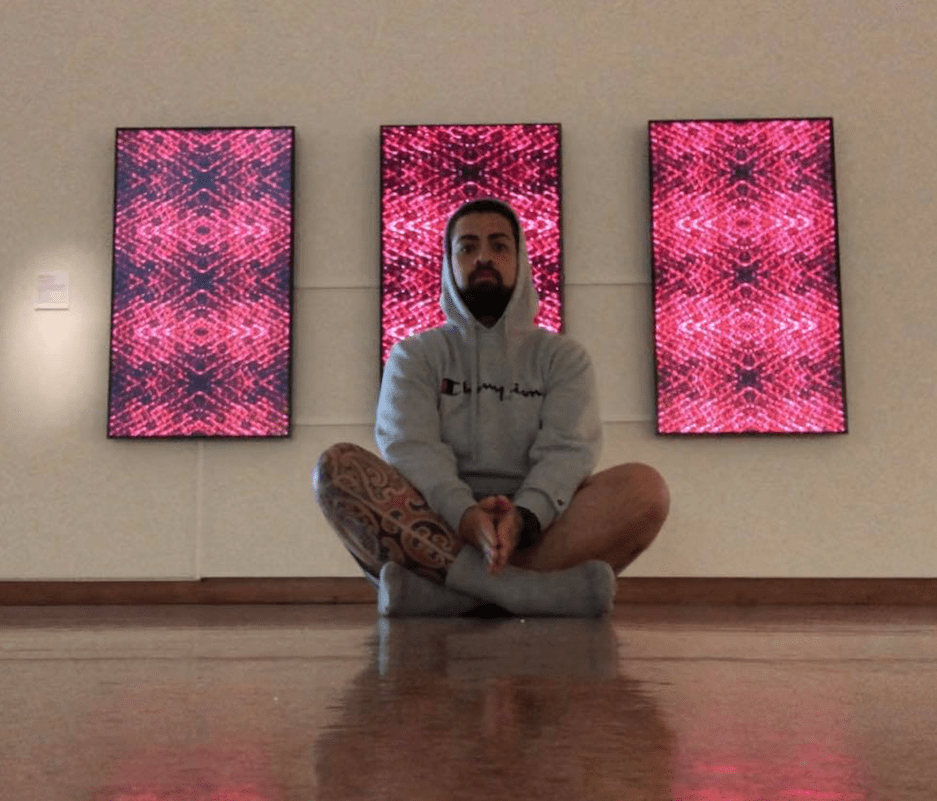I’m paying homage to all the things that we shouldn’t forget about, you know?
Kauri Wharewera (Ngāti Porou, Ngāti Awa, Tūhoe, Te Whānau ā Apanui, Ngāti Kahungunu) is an emerging artist based in Papaioea who creates digital tukutuku using photography techniques and a laser pointer. His animated video Te Kahui o Matariki is this years CIRCUIT commission for Matariki. Curated by Israel Randell for Wellington public art venue Masons Screen, Kauri’s work reinforces the importance of Matariki as “a critical time of year, spiritually, physically and economically.”
Israel Randell (Tainui, Ngāti Kahungunu, Cook Islands) was CIRCUIT’s 2020 Mana Moana Resident and is currently exhibitions curator at Whakatāne Museum & Arts. This kōrero between Israel and Kauri was recorded on the eve of Matariki in Whakātane. Much of the knowledge Kauri draws from comes from the stories of Ngāti Awa, so, says Israel, “it seemed serendipitous that we found ourselves here.”
In the following text, Kauri and Israel discuss the meaning of each Matariki star represented in Te Kahui o Matariki, and consider the potential of contemporary media to tell indigenous stories. The video is available to watch in the text below.
Israel Randell (IR): Wow, how cool is it for you to come home for this kōrero around this time of Matariki!
Kauri Wharewera (KW): Yeah, I’m always finding excuses to come home, so it works out well that you’re working and living here now (also).
IR: I like how that aligned. I didn’t know that you were from here until recently. Engari no hea koe? Ko wai koe?
KW: Kia ora, ko Kauri Wharewera toku ingoa. He uri tenei mo Ngāti Porou, Ngāti Awa, Tuhoe, Te Whānau ā Apanui, Ngāti Kahungunu. I’m a multidisciplinary artist, currently studying at Massey University doing a postgrad in Māori Visual arts.
IR: We first met at Matatau 2020, last year's Māori Visual Arts graduate exhibition at Te Manawa. You had made this three channel work Tuku ka rere (2020) using lasers. You called the channels ‘digital tukutuku’ and I was obsessed with them. Was that the first time you experimented with light?
KW: In my fourth year at Uni I dedicated the entire year to work with light, mostly because I wanted to be like Bob Jahnke. That started me on a journey.
IR: It’s quite a challenge to create works using only light.
KW: In my head I was thinking about light bending. If I was to be an avatar I’d be a light bender, haha. It’s a trippy thing, light. It makes you think of space, stars, time. We have so many Māori narratives that reference light. It comes from the beginning. And if you break it down scientifically, it’s waves of moving electrons reflected off certain things.
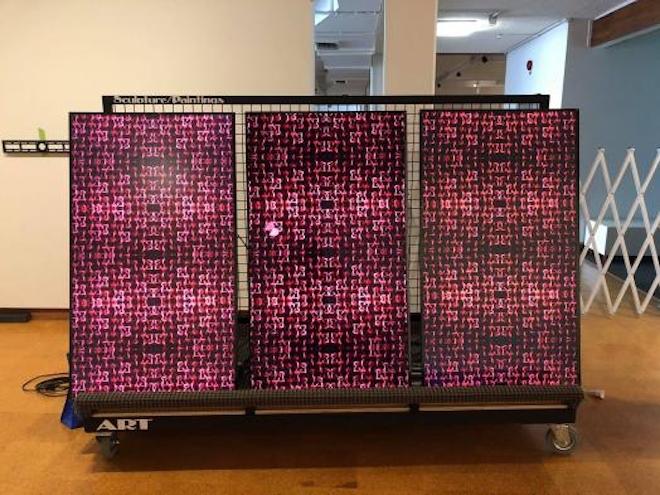
Installation preparation for Kauri Wharewera's Tuku ka rere, Te Manawa (2020)
IR: To be a manipulator of those waves is quite exciting. Let’s talk about the work you made for this commission on Masons Screen. It’s called Te Kahui o Matariki and it’s an 8 minute single channel video that explores each star in the Matariki cluster.
KW: Yeah. Kahui is the name you use for clusters of stars and also clusters of maunga.
IR: Can you talk us through each phase of the video?
KW: The start looks at Ururangi, which is the star that controls the nature of the winds. I wanted to open the work with a simple image. As it moves it becomes blurred, to try to capture how the wind moves. After about a minute, it moves through to Matariki. There is potential to see faces in this part, not fully formed, but sometimes you’ll catch eyes, or a mouth, or nose. This is a play on the name Mata Ariki, which means "face", but it can also mean blade, screen, point or viewfinder. Ariki means chief or describes someone or something of high ranking.
The Matariki star is responsible for the harvesting and planting of crops. It’s a bit of a reset and a time to focus on getting the kumara planted on time and sowing seeds. And once those seeds are sown you can focus on nurturing your crops and slowing down.
IR: Does the order mean anything in this work?
KW: Not really. I’ve ordered them in a way that I thought was visually pleasing—that’s a bit of a Bob [Jahnke] thing. If i had ordered them as they appear in the cluster, from left to right, they could have been too busy.
Kauri Wharewera, Te Kahui o Matariki (2021) Commissioned by CIRCUIT with the support of Wellington City Council
IR: I like the balance [between] the image covering the whole screen and where there is black, or a horizon line.
KW: The main thing I thought about is that I only had one screen. In previous works I’ve had the option of multiple.
IR: Your last work was a triptych.
KW: Yeah. I think that work was successful because it had other works supporting it. [With this work] I was very aware that all the focus would be in the middle of the screen. You wouldn’t be able to move across screens. I found that quite a challenge. With multiple screens you can play with symmetry and in-between spaces.
[In Te Kahui o Matariki], I wanted people's focus to move across the screen, otherwise it just looks like a screensaver.
IR: Haha, there is a fine line between the two.
KW: That's a line I have to draw, making sure that it’s telling a story and isn’t falling into screensaver vibes. [And also], "...am I keeping it uniquely Māori or have I taken it too contemporary [so] that it looks Pākehā?” When the stars and shapes overlap each other you start to get bits of poutama or tukutuku. But instead of weaving with string, I wanted to weave with light.
IR: We’re now at the third minute which is…
KW: Pohutukawa, the star associated with departed souls. For us, when someone dies, the soul starts its journey to wherever they go from here. We go from the rock that Wairaka is on.
IR: Is that a Ngāti Awa thing?
KW: Yeah. The rock is called Turuturu-Roimata, and we start our haerenga from there. In this part of the video the stars come down and pick the souls up from the horizon line. After Pohutukawa, it goes to Waiti and Waitā, which are the stars that control freshwater and saltwater. Essentially they are both water. Visually, I wanted to create ripples.
IR: It’s all connected. The fresh water flows into the ocean, especially here in Whakatāne. There's also an ebb and flow visually.
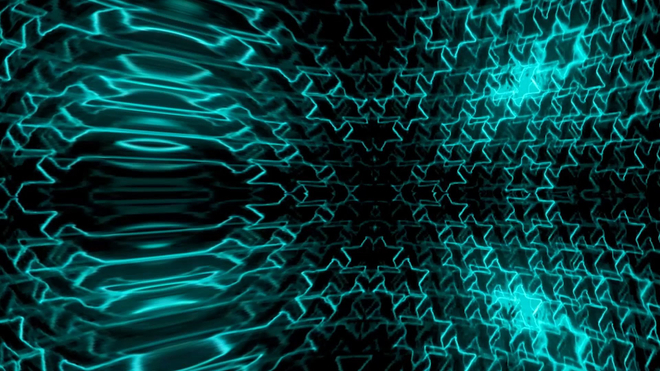
Still from Te Kahui o Matariki (2021) Kauri Wharewera. Commissioned by CIRCUIT with the support of Wellington City Council
IR: Is the next star Tupuānuku?
KW: Yes. This star is responsible for anything that comes from the ground. It grows up from seeds from Papatūānuku. I really enjoy the shapes that start to form in the middle. The next that follows is Tupuārangi, all things that pertain to the sky. I’m paying homage to all the things that we shouldn’t forget about, you know? We should always mihi to the various atua at the right times.
IR: I’ve just started to learn about what hautapu means, and the rituals we used to practice. For example, they used to find one offering from salt water, one from fresh water, one from the sky and one from the ground. In the olden days that would be an ika, a kererū, a kūmara and a tuna. All of those would be put in an umu. As it cooked, the steam would rise and that steam would feed the atua, or be the offering to the atua.
KW: Also, in the everyday they say that when you prepare a big whānau kai and you put it all on the table, and it's steamy, it's usually when you're doing karakia, (and) that's also another offering to the atua.
IR: Ah yes! I totally see that. Have there been any new learnings for you while making this work? I think I’ve learnt the most about Matariki this year.
KW: Dr Rangi Matamua’s 0800 Matariki podcast was really useful for me in making this work. In a perfect world, I’d love the visuals (of Te Kahui o Matariki) to be the length of each episode. Or I would have liked to get permission to use the audio in some way.
Dr Rangi is also from Ruatahuna. It’s cool that he has iwi-specific knowledge and that we both come from Mātaatua waka, because he talks a lot about how different regions should read the sky differently, and I imagine that when he speaks, he is talking from this area.
IR: Is there a reason why this moving image work is silent?
KW: I tried to create an audio soundscape using taonga puoro. I was thinking of also asking Maisey Rika if I could use audio from her album. In the end, I used silence to add some mystery. It also took me a while visually get this work to a point where I was happy. To start that process again with the audio seemed like a large job.
At this point in time I like the work in its current state. But this work has lots of mileage left and there’s still room for it to grow and evolve. My favourite part was working on Waipunarangi, the water that pools in the sky.
IR: I feel like in this section (6:23min) there's a lot of movement and the perspective is quite circular. It feels like the raindrops are falling on my eyeballs.
KW: I wanted this bit to look like we were driving into something, like a worm-hole [at] hyper speed, but also keeping the pattern of the raperape in amongst the design.
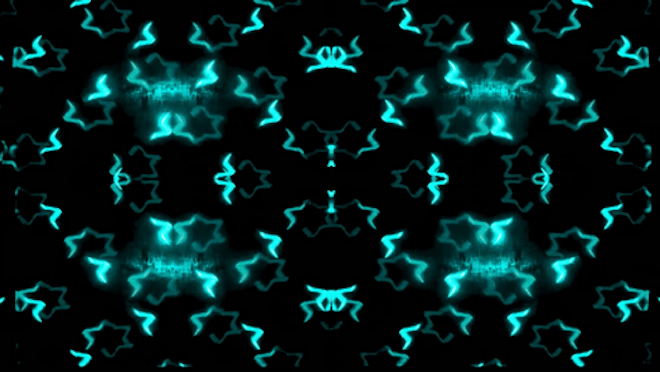
Still from Te Kahui o Matariki (2021) Kauri Wharewera. Commissioned by CIRCUIT with the support of Wellington City Council
IR: What is raperape?
KW: It’s the spiral pattern that we use in moko or whakairo. It's like infinity and beyond. That’s what I tell people when I tattoo raperape on them. It’s like the ripple in the pool that spirals out. It’s a pattern that references growth and learning, but it’s also found in the water. You see that pattern on the surface of the water when rain drops, or when you throw a stone in the water.
As a child, I remember when we would drive to Whakatāne through Murupara and it would be raining so hard that the rain felt like it was almost coming at you. I wanted that type of effect with Waipunarangi. But I also wanted to use the tempo of the video to describe the types of water that pools in the sky. Sometimes it can be soft and sometimes it can be quite hard.
IR: I think it's important to acknowledge all the different types of rain and their functions and notice them and honour them. Rain has such different qualities to hail or snow. But each is unique and needed.
KW: There’s something quite soothing and cleansing about the rain too. There’s life and death in water, but it has that cyclical nature to it, always moving and changing. The next is Hiwa-i-te-rangi, which is the wishing star.
IR: The original manifestation of a New Year’s resolution star, haha.
KW: When you ask for something, you're asking Hiwa-i-te- rangi. And when you receive it, you're thanking Hiwa-i-te- rangi. It's good to remember that some things you ask for take a bit of time.
IR: This looks like DNA, or what I imagine the ether to look like. It’s as if when we wish for things, we bring them out of that space of Te Kore, and into Te Ao Marama.(1)
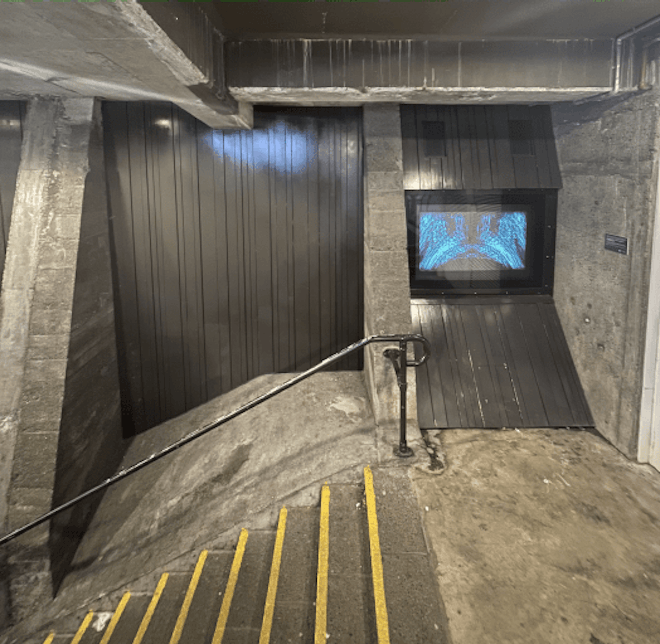
Installation view of Te Kahui o Matariki (2021) Kauri Wharewera. Masons Screen, Wellington
IR: Why have you chosen to use digital media?
KW: That's the Toioho ki Apiti influence. They’re always encouraging you to take your work to the next level. But also, as emerging artists we’re trying to use the technologies of today to communicate ideas past and present. Bob talks a lot about customary, trans-customary and non-customary Māori art. As students we’re pushed to use different media and to be innovative.
IR: I can definitely see the spirit of innovation coming out of Toioho ki Apiti, that’s initially what attracted me to the school as a student, and now as a curator. But I love that everything is grounded in Te Ao Māori also.
KW: And we’re trying to use media that people can relate to now. Our whole world is digital so we move easily in that space. But the way I made this was quite a hands-on process. What you’re seeing here seems effortless but there's been a bit of alchemy in the build up.
IR: What kind of processes have you used to make this?
KW: I made this machine that allows me to draw with the laser. I ended up 3D printing a whole bunch of parts to make this machine. Essentially I created these two shapes that the laser sits on. When you turn them, it pushes that laser either right, left up or down. I also had the piece that I put on the end of the laser that splits the single point laser into multiple points. Then I pretty much shoot [an image] in my hallway by turning this machine and capturing the light trail using a long shutter speed.
IR: I like how hands-on the making is, but how minimal the end result looks.
KW: It’s trippy too, because the artwork relies on the illusion of perception. What you’re seeing is a dot moving so fast that it’s creating a star.
IR: Wow, that’s trippy and then the end result is this? I feel like when you see work like this you don’t anticipate that type of process.
KW: You could animate what I do. It would be way easier and probably crisper. But it’s not as cool, because with this process, essentially I’ve captured light, bent it, changed its colour and sent it back out into the world as a video.
IR: It’s definitely a type of alchemy.
KW: Yeah but with electrons, it’s like i’m a physicist, haha.
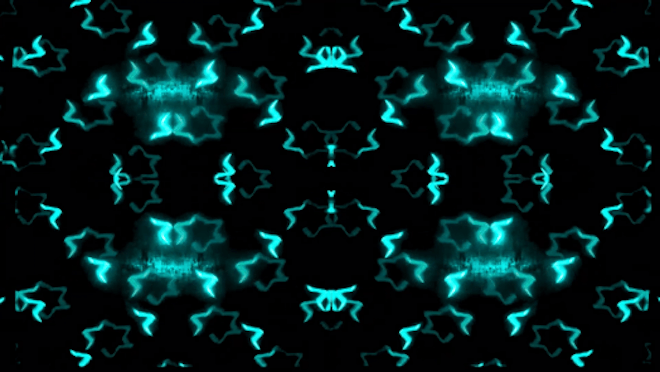
Still from Te Kahui o Matariki (2021) Kauri Wharewera. Commissioned by CIRCUIT with the support of Wellington City Council
IR: Would you ever experiment with VR or AR?
KW: I think this work has the potential to move off the screen, but I’d like to take it into the taiao. The thing with working with digital media is you're quite bound to the screen. Part of my thinking now is, “How can this exist in space?” I thought of the water screen they use on the Wellington waterfront. I saw that they projected onto the steam from the geysers in Rotorua. I like the intersection between digital media and the natural world.
IR: I like those ideas because they connect us to our environment through digital media, [as] opposed to isolating us into the false realities. But I’m also equally as excited for the possibilities of what that medium could provide in the hands of Māori artists. Already Kereama Taepa is doing some dope mahi with 3D printing and Virtual Reality (he’s also a Toioho ki Āpiti alumni).
KW: Yeah. Someone once told me that people from Toioho are real critical thinkers. That's the kind of behaviour that’s fostered. I find it interesting when looking at other arts schools too. You can tell someone who has been to Toihoukura [School of Māori Visual Arts] because of the koru or the colours they use. But people from Palmy are out the gate sometimes. I like that, and I’m stoked to be one of those artists too.
